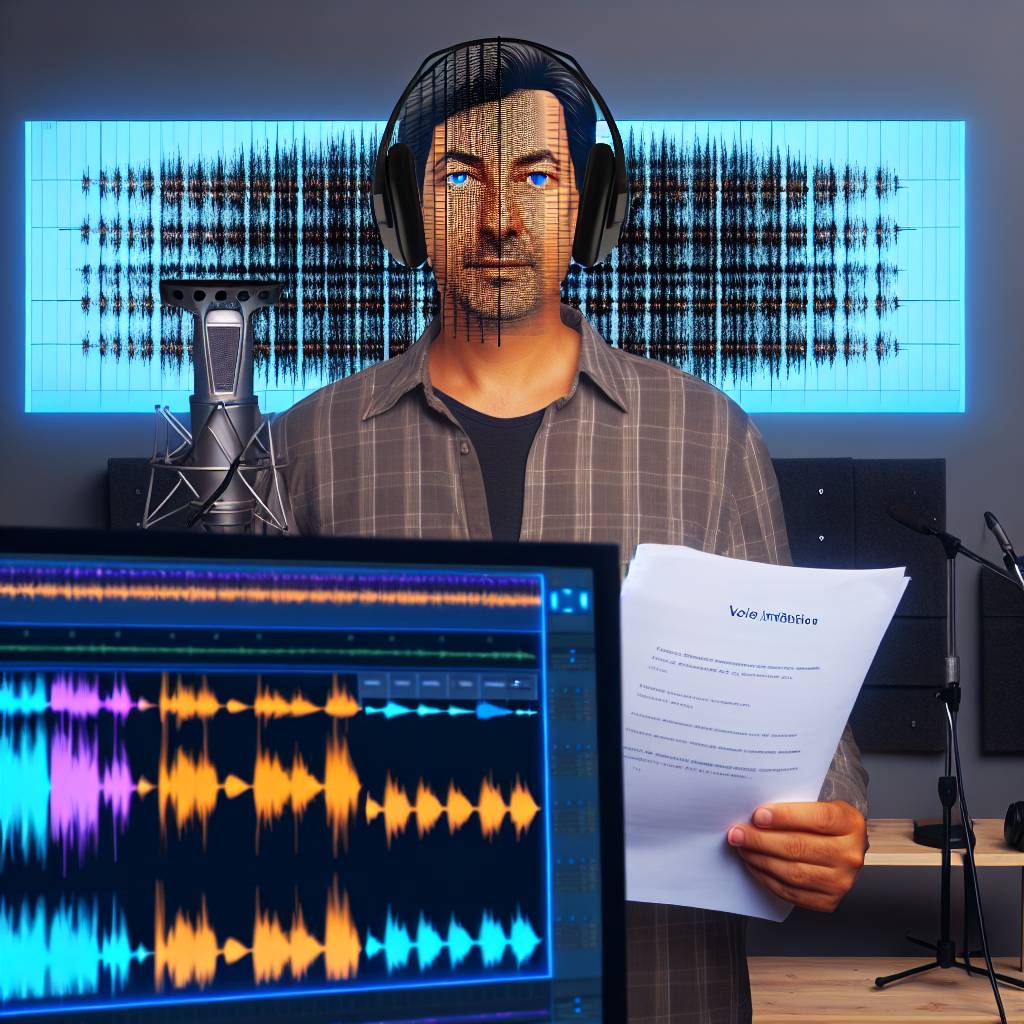Introduction
Let’s explore maximizing AI tools for audio-to-video content creation efficiency
AI tools have become increasingly relevant in today’s fast-paced content creation landscape.
These tools enhance creativity, streamline workflows, and boost productivity.
As digital consumers crave diverse content types, audio-to-video formats have gained immense popularity.
This trend is driven by the growing demand for engaging multimedia experiences.
Audio-to-video content combines spoken words with visual elements, making it more accessible and appealing.
This format captures attention and retains audiences better than audio alone.
As content creators embrace this shift, they must leverage AI tools effectively to maximize their efficiency.
In this blog, we will explore methods for maximizing efficiency using AI tools in audio-to-video content creation.
Understanding these methods allows creators to produce high-quality videos in less time.
AI Tools in Content Creation
AI tools simplify and automate many aspects of content creation.
From transcription to video editing, these technologies enhance every phase of the production process.
They save time and help creators focus on storytelling and creativity.
Importance of Efficiency
Efficiency is crucial in today’s content-driven world.
High-quality output needs to be generated rapidly to meet consumer demand.
By utilizing AI tools, creators can enhance their productivity and maintain creative control.
Exploring AI Applications
AI-driven transcription services convert audio files into text quickly.
These services save time and reduce manual effort.
Next, AI video editing tools automatically synchronize audio tracks with visual elements, streamlining the assembly process.
They also offer features like automatic scene detection and transitions.
Additionally, AI-generated voiceovers provide a cost-effective alternative for creators.
These voices can match various tones and styles, ensuring emotional resonance with the audience.
Maximizing efficiency in audio-to-video content creation is essential for success.
By harnessing the power of AI tools, content creators can produce engaging videos faster and with higher quality.
This approach not only meets audience demand but also fuels the ongoing evolution of digital storytelling.
Understanding Audio-to-Video Content Creation
Definition and Examples of Audio-to-Video Content
Audio-to-video content creation refers to the process of integrating audio elements into video formats.
This combination enhances storytelling and audience engagement.
Various types of audio-to-video content enrich viewer experiences:
- Podcasts and Video Podcasts: Audio discussions accompanied by video footage or slides. These formats allow creators to reach wider audiences.
- Vlogs: Video blogs that pair audio narration with engaging visuals, presenting personal stories or knowledge.
- Online Courses: Educational content using video lessons supplemented by audio explanations for clarity.
- Music Videos: Artistic representations of songs featuring audio and visual elements that accompany musical tracks.
- Documentaries: Informative videos that provide in-depth exploration of topics, where narration drives the visual story.
The Role of Audio in Enhancing Video Narratives
Audio plays a crucial role in video narratives.
It adds depth and context, making stories more compelling.
Various audio elements contribute significantly to video content:
- Narration: Voiceovers guide viewers through a narrative, clarifying complex ideas or emphasizing key points.
- Background Music: Carefully selected music sets the emotional tone of the video, influencing audience reactions.
- Sound Effects: They add realism and immersion, enhancing the storytelling aspect of video content.
- Interviews: Conversation snippets provide insights and humanize stories, creating connections with the audience.
- Ambient Sounds: The subtle background noises enrich scenery, helping audiences feel the environment portrayed.
Importance of Quality in Audio Production for Viewer Engagement
High-quality audio production is vital for viewer engagement.
Poor audio quality can lead to frustration and disengagement.
Consider these factors contributing to the importance of quality audio:
- Clarity: Clear audio ensures that viewers can understand the content without strain, crucial for maintaining interest.
- Professionalism: High-quality audio reflects professionalism, enhancing the creator’s credibility and brand image.
- Emotion: Well-produced audio can evoke emotions, drawing viewers deeper into the narrative.
- Focus: Good audio allows viewers to concentrate on the content without distraction from background noise.
- Inclusivity: High-quality audio pathways can aid accessibility, making content approachable for hearing-impaired audiences.
In summary, audio is more than a supplementary element in video content; it shapes narratives and influences viewer engagement.
We Design & Develop Websites, Android & iOS Apps
Looking to transform your digital presence? We specialize in creating stunning websites and powerful mobile apps for Android and iOS. Let us bring your vision to life with innovative, tailored solutions!
Get Started TodayUnderstanding this balance between audio and video is essential for content creators seeking to maximize the impact of their projects.
Read: Enhancing Retargeting Campaigns with Advanced Link Customization
Overview of Available AI Tools
In recent years, the intersecting fields of artificial intelligence (AI) and media production have rapidly evolved.
Content creators are increasingly utilizing AI tools to enhance audio-to-video content creation.
Below, we will identify popular AI tools that dominate this space, explore their key features, and examine how they compare against traditional methods.
Popular AI Tools for Audio-to-Video Content Creation
Descript
Descript revolutionizes audio and video editing.
Its standout feature is Overdub, a text-to-speech tool that creates voiceovers matching your voice.
Another key feature includes automatic transcription, enabling easy editing right from the text.
You can simply delete or modify words to edit audio or video content.
Synthesia
Synthesia offers AI-generated avatars that deliver video content.
Users input text or audio, and the AI avatar presents it as video.
This tool supports multiple languages and styles, catering to diverse audiences.
It’s perfect for educational or marketing videos, saving significant production time.
Lumen5
Lumen5 uses AI to transform blog posts and articles into videos.
It analyzes the text and selects relevant images and clips for a cohesive end product.
This tool empowers marketers by allowing them to create responsive video content that engages viewers without separate design skills.
Pictory
Pictory transforms scripts into videos quickly.
It focuses on short video creation ideal for social media channels.
Another powerful feature includes auto-captioning, making content accessible to a broader audience.
This ensures that video viewers do not miss critical information.
Veed.io
Veed.io provides an online video editing platform with AI capabilities.
Users can leverage automated subtitle generation and transcription services.
The platform also allows for real-time collaboration among team members, streamlining the production process.
Key Features of Each Tool
Descript
- Text-based editing for audio and video content, simplifying the creative process.
- Overdub technology for seamless voiceover creation.
- Screen recording and video publishing integrated within one interface.
Synthesia
- AI avatars create human-like presentations in videos.
- Support for multiple languages and accents, enhancing accessibility.
- AI-driven video creation promotes consistent branding across content.
Lumen5
- AI-driven automatic media selection based on textual content.
- Drag-and-drop interface allows for intuitive creation of videos.
- Customizable templates provide aesthetic variety while maintaining brand consistency.
Pictory
- Automated video creation based on input scripts, making the process faster.
- Optimized for social media sharing with proper formats and upload capabilities.
- Text-to-video functionality ensures clear storytelling through visual mediums.
Veed.io
- Web-based editing tool that serves as a one-stop solution for video projects.
- Collaboration tools support teamwork and accountability.
- Branding tools help maintain visual consistency across different video assets.
Comparison of Traditional vs. AI-Driven Methods
Understanding the differences between traditional techniques and AI-driven methods is essential for maximizing efficiency.
Below, we highlight key distinctions that affect how content is created.
Speed and Efficiency
Traditional methods often require extensive time management skills and multiple team members.
In contrast, AI tools provide faster turnaround times with automation.
For instance, automatic transcription tools significantly reduce time spent on manual captioning.
Skill Requirements
Traditional content creation typically demands expertise in audio and video editing software.
Many creators may spend years honing these skills.
Conversely, AI tools simplify the process, allowing individuals without technical expertise to produce professional-quality content.
Users can leverage these tools with minimal training.
Creativity and Innovation
While traditional methods might thrive on human creativity, AI tools introduce new ways to conceive ideas.
Generative AI can analyze trends and suggest content direction.
As a result, content creators can maintain relevancy while also optimizing their output.
We Design & Develop Websites, Android & iOS Apps
Looking to transform your digital presence? We specialize in creating stunning websites and powerful mobile apps for Android and iOS. Let us bring your vision to life with innovative, tailored solutions!
Get Started TodayCost Efficiency
Investing in traditional production often involves hefty costs.
This includes hiring professionals, renting equipment, and assigning prolonged projects.
On the other hand, many AI tools come at a fraction of the cost.
This democratizes content creation, making it accessible to businesses of all sizes.
Outcome Quality
The integration of AI ensures that project outcomes maintain a certain standard.
AI tools generate consistent quality across productions.
Traditional methods can yield varied results depending on the team’s skill level and experience.
As media landscapes evolve, leveraging AI tools presents a significant advantage in audio-to-video content creation.
From enhancing productivity to reducing costs, these tools are changing how creators approach their work.
The future of content creation lies in embracing both technology and creativity, allowing endless possibilities for every creator.
Read: AI-Driven Marketing: Revolutionizing Strategy & Content Creation
Streamlining the Editing Process with AI
Creating audio-to-video content can be a labor-intensive process.
Editors often spend hours aligning audio tracks with video footage.
However, advancements in AI tools have emerged, transforming and streamlining the editing process dramatically.
These tools not only save time but also enhance the overall quality of the content.
Automating Editing Tasks
AI tools excel at automating many tedious editing tasks.
These tasks, such as syncing audio with video and cutting unnecessary segments, often consume significant editing time.
By deploying AI technology, content creators can maintain focus on creativity instead of tedious technicalities.
Syncing Audio with Video
One of the most time-consuming aspects of editing is syncing audio tracks with video footage.
Traditionally, editors rely on manual adjustments to ensure the audio matches the video.
AI tools have revolutionized this process:
- Automatic Syncing: AI algorithms analyze audio waveforms and video cues. They automatically align the audio track with the corresponding video.
- Real-Time Analysis: AI tools work in real-time. This capability drastically cuts down the time spent on syncing, allowing editors to concentrate on creative aspects.
Removing Unnecessary Segments
Editors often sift through extensive footage to find the best segments.
AI helps automate the selection process:
- Identifying Inactive Segments: AI detects moments of silence or inactivity, marking them for removal. This keeps the content engaging and concise.
- Content Recommendations: Some AI tools offer suggestions for which segments to keep or cut based on predefined criteria. This leaves editors with more time for creative decisions.
Enhancing Editing Speed and Accuracy
The integration of AI in the editing workflow considerably speeds up the process.
In addition to speed, AI enhances accuracy in several ways:
Boosting Speed
AI-driven editing tools streamline operations, and here’s how:
- Batch Processing: AI can process multiple clips simultaneously. This ability dramatically reduces overall editing time.
- Smart Shortcuts: AI provides shortcuts for repetitive tasks. Editors can execute commands quickly, saving time.
- Suggested Edits: AI analyzes footage to propose edits. These suggestions can help editors make quick decisions.
Improving Accuracy
AI also provides unparalleled accuracy in editing.
This occurs through:
- Content Analysis: AI examines video frames for relevance and engagement. This thorough analysis ensures every segment serves the content’s purpose.
- Quality Control: AI tools can identify audio inconsistencies. This feature ensures the final product maintains high quality.
- Consistency in Editing Style: AI tools can learn a preferred editing style. This learning allows them to apply a consistent look across various videos.
Case Studies and Examples
Numerous case studies showcase how AI editing tools have transformed productivity and efficiency in audio-to-video content creation.
Here are a few notable examples:
Example 1: Major Media Company
A renowned media company incorporated AI editing tools to enhance productivity:
- Increased Efficiency: The AI tools slashed editing time by over 50%. The team spent less time on mundane tasks and more on creative storytelling.
- Higher Output: As a result, the company increased its video output by 30%. This growth allowed for more engaging content across platforms.
Example 2: Independent Content Creator
An independent content creator adopted AI tools to streamline her editing process:
- Simplified Workflow: With automated syncing and cut suggestions, she completed projects faster. She reported a 40% decrease in time spent editing.
- Enhancing Quality: The tools improved audio-video synchronization, resulting in higher viewer engagement rates.
Example 3: Educational Institutions
Several educational institutions have begun using AI editing tools:
- Reducing Workload: Educators found that AI reduced the workload significantly. They spent fewer hours editing lessons.
- Focus on Content Creation: Instructors redirected their focus toward content creation and interaction with students, enhancing the learning experience.
The Future of AI in Video Editing
The future of AI in video editing looks promising.
As technology continues to evolve, we can expect even greater enhancements in the workflow:
We Design & Develop Websites, Android & iOS Apps
Looking to transform your digital presence? We specialize in creating stunning websites and powerful mobile apps for Android and iOS. Let us bring your vision to life with innovative, tailored solutions!
Get Started Today- Advanced Editing Features: Future AI tools will likely include more sophisticated editing features, such as automatic content suggestion based on audience analysis.
- Integration with Other Platforms: AI could seamlessly integrate with other content creation platforms. This integration would facilitate a smoother editing experience.
- Personalized Editing Experience: AI may offer a more personalized editing approach, adapting to the unique style of each creator.
Therefore, streamlining the editing process with AI represents a significant shift in the audio-to-video content creation landscape.
By automating tedious tasks, enhancing speed and accuracy, and showcasing successful case studies, AI tools empower creators to focus on crafting engaging stories.
As technology continues to advance, embracing these tools will be crucial for content creators seeking efficiency and quality.
Read: Revolutionize Accounting with AI-Powered Automation & Smart Categorization

Enhancing Audio Quality Using AI
In today’s digital landscape, audio quality stands as a crucial element of video creation.
Poor audio can diminish audience engagement, regardless of how visually captivating a video may be.
AI tools offer an innovative solution to enhance audio clarity and eliminate unwanted background noise.
This section explores AI technologies that significantly improve audio quality in video projects.
Overview of AI Tools That Improve Audio Clarity
Several AI-powered tools have emerged, designed specifically to enhance audio clarity and ensure a polished sound in video content.
These tools leverage advanced algorithms to analyze and process audio tracks effectively.
Here is a selection of popular AI tools used to improve audio quality:
- Auphonic: This tool automatically adjusts audio levels, removes background noise, and optimizes sound for various formats.
- Adobe Audition: Features powerful noise reduction capabilities and AI-driven sound restoration tools.
- iZotope RX: This advanced audio restoration software excels in isolating audio elements and removing distractions.
- Descript: A versatile tool that provides transcription, audio editing, and background noise reduction features.
- Krisp: Focuses on real-time noise cancellation, perfect for live recordings or podcasts.
These tools simplify the audio enhancement process, allowing creators to focus on content quality and narrative rather than technical details.
With AI’s assistance, audio quality can be significantly improved with minimal effort.
Techniques for Voice Enhancement and Sound Mixing Using AI
AI-driven techniques for voice enhancement and sound mixing are transforming how sound is integrated into video content.
Understanding these techniques can help creators produce professional-grade audio.
Here are some effective AI methodologies:
- Dynamic Range Compression: AI algorithms intelligently adjust audio levels, ensuring loud sounds don’t overpower softer ones.
- Equalization: AI can automatically adjust frequencies to enhance clarity. It boosts essential frequencies while reducing problematic ones.
- De-noising: AI tools effectively identify and suppress background noise, allowing the main audio to shine through.
- Vocal Removal: Some tools can isolate vocals, making it easier to remix tracks or create karaoke versions of songs.
- Reverb Reduction: AI can analyze room acoustics and reduce unwanted reverb, leading to clearer audio.
These techniques not only improve the overall sound quality but also create a more immersive experience for the audience.
Implementing these methods can elevate a creator’s audio production to a professional standard.
Importance of High-Quality Audio in Video Content
High-quality audio plays a pivotal role in video content creation.
Many studies show that viewers often associate audio quality with overall production value.
Here’s why focusing on audio is vital:
- Improved Engagement: Clear audio keeps viewers engaged. Poor sound can lead to frustration and disinterest.
- Enhanced Message Retention: Viewers remember information better when audio quality is high. Clear audio aids comprehension.
- Professionalism: Audiences perceive high-quality audio as a sign of professionalism. This perception can enhance a brand’s reputation.
- Emotional Impact: Good sound design can evoke emotions. Music and sound effects enhance storytelling and audience connection.
- Accessibility: High-quality audio allows for better subtitling and transcription. It ensures accessibility for all audiences.
Incorporating AI tools into the audio enhancement process acknowledges this crucial importance.
It allows creators to focus on storytelling while AI handles the technical aspects of audio quality.
Case Studies of Successful Audio Enhancement
Numerous successful content creators have leveraged AI to maximize their audio quality.
These case studies provide insights into the effectiveness of AI tools:
- Podcast Creators: Many podcast hosts use tools like Auphonic to ensure clear audio. This has led to increased listener retention and engagement.
- YouTubers: Content creators on platforms like YouTube employ iZotope RX for audio cleanup. These enhancements have dramatically boosted their subscriber counts.
- Online Educators: Educators using Descript for audio editing have reported improved student satisfaction. Clear audio improves the learning experience significantly.
These success stories highlight the profound impact AI tools can have on audio quality.
They showcase the tangible benefits that come from investing in the right technologies.
Enhancing audio quality using AI is no longer a luxury; it’s a necessity for effective video content creation.
With AI tools available for noise reduction, voice enhancement, and sound mixing, creators can achieve professional results with relative ease.
The importance of clear audio in engaging audiences and conveying messages cannot be overstated.
By embracing AI technologies, creators can focus on their narratives while ensuring that their audio captivates and retains their audience.
In a world where content is king, high-quality audio represents an essential component of a successful strategy.
Read: Revolutionizing Content Creation with AI-Powered Voice & Chat Tools
Integrating AI-generated Visuals with Audio
As creators increasingly rely on audio content, integrating visuals enhances storytelling.
AI tools now make this integration more accessible than ever.
We Design & Develop Websites, Android & iOS Apps
Looking to transform your digital presence? We specialize in creating stunning websites and powerful mobile apps for Android and iOS. Let us bring your vision to life with innovative, tailored solutions!
Get Started TodayThey can generate visuals that perfectly complement audio narratives.
This section explores the best practices for marrying audio and visual elements seamlessly.
Furthermore, we will analyze how visuals impact audience engagement.
AI Tools for Generating Visuals
A variety of AI tools now exist to help you generate visuals.
These innovations cater to different content needs and creativity levels.
Here are some popular AI tools for creating visuals:
- DALL-E: This model by OpenAI generates images from textual descriptions. It offers a robust creative tool for visual storytelling.
- DeepArt: By utilizing neural networks, DeepArt transforms photos into artwork. This tool adds an artistic flair to standard visuals.
- Canva: While not purely AI, Canva integrates AI features like Magic Resize and image suggestions. It simplifies the design process considerably.
- Piktochart: This tool allows you to create infographics quickly. Its AI-driven design recommendations make it user-friendly for beginners.
- Runway ML: Runway enables creators to generate and edit visuals using machine learning. It bridges the gap between complex editing software and simplicity.
These tools help you create visuals that resonate with your audio content.
Their AI capabilities provide a substantial advantage, allowing for experimentation and quick iterations.
Best Practices for Marrying Audio and Visual Elements Seamlessly
Combining audio and visuals effectively requires thoughtfulness and planning.
Here are some best practices to follow:
- Align Themes: Ensure the visuals align thematically with the audio content. This consistency enhances the overall narrative.
- Maintain Consistent Branding: Use colors, fonts, and styles that represent your brand throughout the audio-visual material. This builds recognition and trust.
- Use Complementary Colors: Colors evoke emotions. Choose a color palette that complements your audio’s mood.
- Enhance Key Messages: Use visuals to highlight important ideas in your audio. This emphasis keeps the audience engaged and informed.
- Incorporate Subtitles: Adding subtitles increases accessibility. Such visuals complement audio messages and helps retain attention.
- Balance Audio and Visual Elements: Ensure neither element overshadows the other. Aim for harmony to create a unified experience.
- Test and Iterate: Gather audience feedback. Use it to refine your integration of visuals and audio over time.
Following these practices enhances audience experience when consuming your content.
You ensure that your visuals support rather than distract from your audio message.
Analyzing the Impact of Visuals on Audience Engagement
Visual content holds a powerful sway over audience engagement.
Numerous studies have shown that people process visuals much faster than audio alone.
This speed can increase the overall effectiveness of your content.
Here’s how visuals impact engagement:
- Retention: Audiences are more likely to remember information paired with visuals. Creating a memorable experience boosts retention rates.
- Increased Shareability: Engaging visuals encourage sharing across social media platforms. Viewers are more inclined to share visually appealing content.
- Enhanced Emotional Impact: Visuals trigger emotions. They can evoke feelings that complement the audio message, making the overall content more engaging.
- Improved Understanding: Visuals clarify complex concepts. They simplify grasping intricate ideas presented in the audio format.
- Audience Reach and Accessibility: Visual content caters to diverse audiences. It transcends language barriers and aids those with hearing impairments through subtitles.
Research supports that combining audio and visuals can double audience engagement compared to audio alone.
Such integration leads to higher viewer satisfaction and retention.
Creators should not underestimate the transformative power of visuals in their projects.
In fact, the synergy between audio and visuals significantly enriches content creation.
By utilizing AI tools effectively, you can generate compelling visuals that resonate with your audience.
Adopting best practices ensures these elements work together to tell cohesive stories.
Lastly, understanding the impact of visuals on audience engagement will help elevate your content strategy.
Embrace AI-generated visuals as not just enhancements but vital components of your audio storytelling.
Optimizing Workflow with AI Collaboration
In today’s fast-paced digital landscape, efficiency is paramount.
Incorporating AI tools into existing workflows can significantly enhance audio-to-video content creation.
This section explores various strategies, tips, and insights into the future of human-AI collaboration.
Strategies for Incorporating AI Tools into Existing Workflows
Integrating AI into your creative processes requires careful planning.
Consider the following strategies to optimize workflow:
- Assessment of Current Workflows: Analyze your existing processes. Identify bottlenecks and repetitive tasks that AI can help streamline.
- Selection of Appropriate AI Tools: Choose AI tools that align with your specific content needs. Consider options for audio transcription, video editing, and content generation.
- Pilot Testing: Before full implementation, conduct pilot tests. Use a small team to evaluate the effectiveness of selected AI tools.
- Integration with Existing Software: Ensure that the AI tools can seamlessly integrate with your current software. Compatibility improves user experience and efficiency.
- Feedback Loops: Create mechanisms for user feedback. Encourage your team to share their experiences and suggest improvements.
- Gradual Scaling: Once tools prove effective, gradually scale their usage. Expand AI integration to more teams and projects over time.
Tips for Training Teams to Effectively Use AI in Content Creation
Successful integration of AI tools hinges on user proficiency and confidence.
Here are some tips for training your teams:
- Structured Training Programs: Develop comprehensive training modules. Cover the features and capabilities of each AI tool thoroughly.
- Hands-On Workshops: Organize workshops where team members can practice using AI tools. Real-world scenarios help reinforce learning.
- Collaborative Learning Environment: Encourage teamwork during training. Learning together fosters collaboration and collective problem-solving.
- Resource Availability: Provide easy access to training materials. Distribute manuals, guides, and video tutorials for ongoing support.
- Encouraging Experimentation: Motivate teams to explore AI tools. Allow room for trial and error during the learning process.
- Regular Check-Ins: Schedule follow-up sessions to assess progress. Use these moments to address challenges and resolve issues.
The Future of Collaboration Between Humans and AI in Creative Processes
The relationship between humans and AI is evolving.
As technology advances, so does the potential for creative collaboration.
Here are some future trends to anticipate:
- Enhanced Creativity: AI can inspire new ideas and perspectives. This capability allows teams to break creative boundaries and innovate.
- Demand for Human Oversight: Despite AI efficiency, human input remains essential. Professionals will oversee AI-generated content for quality and alignment with brand voice.
- Advancements in AI Learning: Future AI tools will become more intuitive. They will learn and adapt to specific workflows and individual preferences.
- Ethical Considerations: As AI plays a larger role, ethical dilemmas will arise. Organizations must establish clear guidelines for responsible AI use.
- Seamless Integration: Future AI tools will offer greater compatibility with creative software. Users will experience smoother transitions between tasks.
- Telepresence in Creative Meetings: AI will facilitate remote collaboration through virtual environments. Teams can brainstorm and create together, regardless of location.
By maximizing AI tools in audio-to-video content creation, professionals can optimize efficiency dramatically.
We Design & Develop Websites, Android & iOS Apps
Looking to transform your digital presence? We specialize in creating stunning websites and powerful mobile apps for Android and iOS. Let us bring your vision to life with innovative, tailored solutions!
Get Started TodayThese strategies and tips will help your team embrace AI technologies confidently.
As we move forward, cultivating a harmonious relationship between human creativity and AI capabilities will redefine content creation.
In essence, the potential of AI in transforming workflows and enhancing creativity is immense.
By thoughtfully integrating AI, organizations can future-proof their content production processes.
Investing in team training and adapting to technological advancements will drive long-term success in the evolving landscape of audio-to-video content creation.
Analyzing Performance and Audience Engagement
Creating audio-to-video content is not just about converting audio files.
It’s about maximizing engagement and understanding viewer interaction.
Hence, analyzing performance and audience engagement becomes crucial for content creators.
Utilizing the right tools helps to measure the impact effectively.
AI technologies play a significant role in this process.
We can leverage AI to collect and interpret vital viewer data.
This section will delve into tools, the role of AI, and how to adapt content strategies based on performance metrics.
Tools for Measuring the Impact of Audio-to-Video Content on Audiences
Recognizing the effectiveness of your audio-to-video content involves specific tools.
Here’s a list of popular tools that help measure audience engagement:
- Google Analytics: This tool tracks user behavior on your video platforms. It provides metrics such as views, viewer retention, and demographics.
- Social Media Insights: Platforms like Facebook, Instagram, and YouTube offer built-in analytics. They reveal how viewers interact with your content through likes, comments, and shares.
- HubSpot: This marketing platform offers detailed analytic reports. You can analyze how audio-to-video content affects lead generation and conversions.
- Vidyard: Vidyard specializes in video analytics. It provides insights into how videos perform, including viewer engagement levels and dropout rates.
- Wistia: Wistia provides in-depth analytics specifically for video. It shows heatmaps of video engagement and optimal viewer drop-off points.
Using these tools allows you to gather substantial data.
Tracking audience engagement is essential for understanding what resonates.
With accurate metrics, you can refine your content strategies.
These tools help you focus on producing more engaging audio-to-video content.
The Role of AI in Analyzing Viewer Data and Feedback
Artificial Intelligence significantly enhances the analysis of viewer data.
It automates many processes that were traditionally manual.
Here are key ways AI adds value to data analysis:
- Automated Data Collection: AI can aggregate data across multiple platforms. It compiles viewer analytics into one coherent report.
- Sentiment Analysis: AI can analyze viewer feedback and comments. This helps in gauging audience sentiment toward your content.
- Predictive Analytics: AI algorithms can forecast trends. They provide insight into how specific content types will perform in the future.
- User Personalization: AI utilizes viewer behavior data to tailor recommendations. Thus, it enhances content delivery and user experience.
- Enhanced Engagement Metrics: AI tracks finer details in viewer behavior. It goes beyond mere views to measure engagement, such as pause and rewind rates.
AI simplifies the process of extracting actionable insights from your data.
It informs your content creation strategy effectively.
By understanding how viewers interact with your videos, you can create content that resonates more deeply.
Adapting Content Strategies Based on Performance Metrics
Adjusting your content strategy according to performance metrics is crucial.
When you analyze and evaluate your data, do not let it remain static.
Here’s a step-by-step approach to adapting content based on performance:
- Regularly Review Analytics: Make it a habit to frequently check your analytics reports. Identify which videos performed well and which did not.
- Understand Audience Preferences: Use data to segment your audience further. Analyze what types of content resonate with different viewer segments.
- Test Different Formats: Experiment with various audio-to-video formats. You could try animation, live-action, or graphical representations to see which garners more engagement.
- Adjust Release Timing: Analyze data to identify peak viewing times. Adjust your release schedule accordingly to maximize initial views.
- Incorporate Viewer Feedback: Pay attention to comments and viewer suggestions. If viewers request specific content types, consider incorporating these ideas.
By adapting your content strategies based on these metrics, you foster continuous improvement.
This not only enhances viewer engagement but also builds a loyal audience base.
Engage frequently with your analytics to drive your adjustments.
Moreover, keep an eye on emerging trends.
Content strategies evolve as viewer preferences shift and technology advances.
Regularly adapting will keep your content relevant and appealing across diverse audiences.
Continuous learning and refinement based on analytics should be a priority.
Generally, analyzing audience engagement is essential for maximizing the effectiveness of audio-to-video content.
We Design & Develop Websites, Android & iOS Apps
Looking to transform your digital presence? We specialize in creating stunning websites and powerful mobile apps for Android and iOS. Let us bring your vision to life with innovative, tailored solutions!
Get Started TodayUsing the right tools for measurement helps assess performance accurately.
AI plays a vital role in enhancing data analysis, providing insights into viewer preferences.
Adapting content strategies based on performance metrics ensures that your content remains engaging and relevant.
As you continue to develop your audio-to-video projects, prioritize these aspects to enhance your overall efficiency and viewer satisfaction.
Conclusion
Recap of the importance of maximizing AI tools for efficiency in audio-to-video content creation
Maximizing AI tools significantly enhances efficiency in audio-to-video content creation.
These tools save time and streamline workflows.
By automating repetitive tasks, creators can focus on more critical aspects of their projects.
As a result, the quality of output improves, leading to more engaging content.
Encouragement to stay updated with emerging AI technologies
Staying updated with emerging AI technologies is essential for all creators.
The landscape of digital content is ever-evolving, and new tools regularly emerge.
Engaging with the latest advancements ensures you remain competitive in the industry.
Explore webinars, courses, and tech news to keep your skills sharp.
Final thoughts on the future of content creation and the role of AI in enhancing creativity and productivity
The future of content creation looks bright with AI.
These technologies enhance creativity and productivity in unprecedented ways.
As AI tools become more sophisticated, they will provide even greater support to content creators.
Embracing this technology can lead to innovative storytelling techniques and more engaging viewer experiences.
Leveraging AI tools can revolutionize how we create audio-to-video content.
Their potential to increase efficiency is immense and transformative.
As technology continues to advance, staying informed will ensure creativity flourishes.
The integration of AI into content creation presents exciting possibilities for the future.
Before You Go…
Hey, thank you for reading this blog post to the end. I hope it was helpful. Let me tell you a little bit about Nicholas Idoko Technologies.
We help businesses and companies build an online presence by developing web, mobile, desktop, and blockchain applications.
We also help aspiring software developers and programmers learn the skills they need to have a successful career.
Take your first step to becoming a programming expert by joining our Learn To Code academy today!
Be sure to contact us if you need more information or have any questions! We are readily available.
Put Your Tech Company on the Map!
Get featured on Nicholas Idoko’s Blog for just $200. Showcase your business, boost credibility, and reach a growing audience eager for tech solutions.
Publish Now









